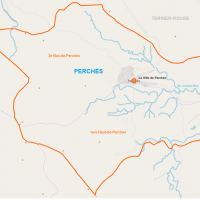Les Perches

Perches, is one of the smallest municipalities in the Fort-Liberté Arrondissement, is part of the Nord-Est Department. It contains two communal sections, Haut-des-Perches and Bas-des-Perches, and a population of barely 12,000.
Perches is an interior commune. Its dominant terrain is the hills and its climate is normal. This small town in mountainous northeast Haiti is contrasted by its cooler mountain air and fresh puddles of rain; are a pleasant change from the heavier populated lowland areas. Its inhabitants are called Perchoise. In 1998, the population of perch was estimated at 7,825 inhabitants, projected at 8,567 inhabitants in 2004. For an area of 1.89 km2, its town center density was 3,560 inhabitants per km2 (9,429 per sq mi).
Economy: This is a place where many of the people travel long distances to get water from rivers that are most likely contaminated. The chief means of producing income in Perches is through sustainable farming. Pistachio, nut, corn, mango, orange, and lime crops are raised. Livestock farming as well as gold mining is also practiced.
The Perches commune is poor in economic and financial infrastructure. Agriculture, trade and livestock represent the main economic activities. Four food-supply centers, two large shops and a photography service form the commercial and economic establishments of the commune.
Infrastructure: Like other cityships within the Fort-Liberté Arrondissement, Perches lacks electrical and road systems. If one wants to get to central parts of Perches, they must use hiking trails. Also lacking its own airport, Perches remains difficult to get to, especially for non-government organizations (NGO) there to start infrastructure projects.
Education: The Ministry of the National Education of Youth and Sports is not represented in the commune of Perches. The town has no kindergarten. A public school and several private, were inventoried at the primary level. There is also a high school and three vocational schools. On the other hand, there is no Literacy center, no university, nor other colleges.
Health: The Ministry of Public Health and Population is not represented in the Perche commune. A nurse, two auxiliary, and Eleven certified Matrons are the health staff of the commune.
Utilites: The commune of Perches has six rivers, over two dozen Springs and thirteen lagoons. Only the urban section is electrified. The frequency of feeding is twelve hours on average per week.
Another weakness in Perches’ infrastructure is lack of availability to decontaminated water for drinking, cooking, washing, and bathing. It is unknown how many cases of cholera have been reported, as statistics either have not been compiled or are inaccessible. But an NGO, the Chariton Rotary Club, has initiated a plan to build wells in Perches, so decontaminated water will be available to the residents in the future.
In response to the infrastructure problems in Perches and many other cityships across Haiti, the government of Haiti, along with its global partners, are pushing a 10-year plan to build and maintain basic services all across Haiti. But places like Perches will likely have a very long wait as the project has not generated much response among the international community.
Religion: Fourteen churches were listed in the commune. The Baptist churches were revealed to be more numerous, six in total.
Organizations: The municipality has a political representation, four Popular organizations, four peasantsgroups of peasants and a womens group.
Communication: At the time of the inventory the municipality did not have a telephone office. There was no radio station, newspaper/magazine nor television station.
Leisure: As for leisure, the commune has no library, museum, nor movie theater. The parish Hall serves as a theatre during the summer holidays. For monuments and sites, the municipality only has one: the fall of Dimicalain. This “fall” forming a basin known as the Saint Anthony Basin of Padua is considered a mystical and pilgrimage place. He receives the visit of many followers of the Vodun on Tuesday, Thursday and Friday of each week.

